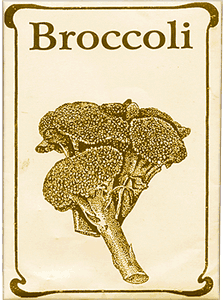BROCCOLI
Vitals
• Brassica oleracea, belonging to the mustard family, Brassicaceae/Cruciferae.• Origins: Asia Minor and eastern Mediterranean.
• Early literary reference: Roman naturalist Pliny the Elder wrote that his people enjoyed broccoli during the first century AD.
• Climate: Moist and cool (40–70 °F; 5–20 °C).
Ah, there’s nothing in the world quite like broccoli. Well, nothing except cabbage, cauliflower, kale, brussels sprouts, collard greens, and kohlrabi. All of these vegetables are, in fact, the same species, Brassica oleracea . They all stem (if you’ll pardon the pun) from a wild mustard plant that has been bred in various ways to enhance nutrition or yield, or make it easier to grow and harvest.
Broccoli and the other varieties of B. oleracea are a good example of how farmers can alter the traits of their crop plants through a process called “artificial selection.” Artificial selection has given us nearly all the vegetables we eat today, to most of which bear only a passing resemblance to the plants from which they came. Farmers around the world continue use this process to develop new varieties that are adapted to their climates, soil conditions, harvesting methods, and so on. (How do they do this? See our article Why Save Seeds?)
How does artificial selection work? Essentially, it’s a farmer harnessing natural selection, one of the main forces behind evolution, and putting his or her own agenda on it. In fact, Darwin made careful observations of artificial selection being done by rock-pigeon breeders, and what he saw led him to his theory of evolution by natural selection.
The idea is this: In any population of organisms, whether they be birds or broccoli, the individuals differ from each other in small ways. If a farmer wants stronger stems on a plant to withstand windy storms, he can find the two plants with the strongest stems growing in his field and cross-pollinate them. The offspring they produce will likely show stronger stems than most of the plants from their parents’ generation. (What’s pollination got to do with it? Find out more in our The Secret Lives of Flowers ). Darwin figured that if farmers and breeders can exert this “selective pressure” on plants to make changes over short periods like five or ten years, nature can exert the same sort of pressure over millenia. In the case of natural selection, the pressure comes from the environment in which the organism lives. The ones best adapted to their environment are the most likely to produce offspring and pass on those traits (among others) that give them their advantage.
Over the centuries, farmers breeding wild mustard for flowers, buds, stems, and leaves produced the variety of plants we know today as the “cole crops.” Any of these plants will readily cross with the others. The “brocciflower” that you find occasionally in the grocery store is one example. But there’s no guarantee that every cross among these same-species plants will be very tasty. Perhaps there’s a reason we don’t see brussels broccoli or cauli-kale at the farmers' market.
Links:
Darwin’s chapter on artificial selection in
The Origin of
Species
.
http://www.literature.org/authors/darwin-charles/the-origin-of-species/chapter-01.html
For more on how farmers select for certain traits, see our article Why Save Seeds?
Saving the seedBroccoli is one of the trickier vegetables when it comes to saving seed. For starters, a broccoli plant won't pollinate itself, so you’ll need to grow several broccoli plants close together. To make matters more complicated, broccoli will readily cross with any other plant of the same species—cabbage or cauliflower, for example. So you should plan on raising only one form of B. oleracea in your garden if you want to save seed. Seeds are viable for about five years.
• Choose the broccoli plant that exhibits the traits you most want to keep. Broccoli heads, the part we eat, are clusters of unopened flower buds. So don't eat the broccoli head from your best plant, or you'll be eating the source of your seeds!
• The green broccoli head will turn yellow as the flowers that make it up mature. The flowers will become pods, and these are what contain the seeds.
• When the pods are dry on the plant, cut the plant from the ground and hang it for a week or two to dry.
• Remove the pods and put them in a bag. Crush them with a rolling pin or your hands to get the seeds out.
• Separate the seeds from the chaff. You can winnow them (sift them from one container to another, letting the wind blow the chaff away) or pass them through a screen, leaving the chaff behind.
